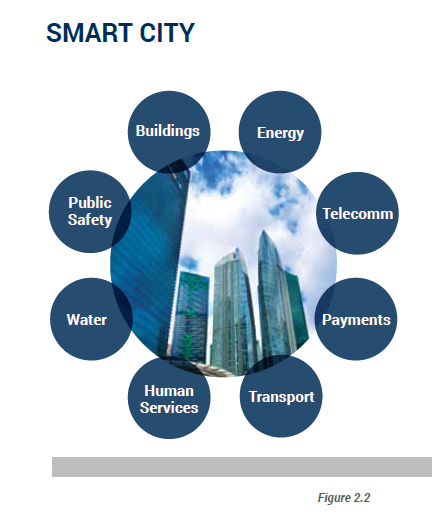 On November 18th, the Smart Cities Council released the Smart Cities Council Readiness Guide at the Smart City Expo World Congress in Barcelona, Spain. I am privileged to be a member of the Smart Cities Council Advisory Board, and in such a capacity, served as a review for the Guide.
On November 18th, the Smart Cities Council released the Smart Cities Council Readiness Guide at the Smart City Expo World Congress in Barcelona, Spain. I am privileged to be a member of the Smart Cities Council Advisory Board, and in such a capacity, served as a review for the Guide.
The Smart Cities Council Readiness Guide is the first of its kind—a comprehensive, vendor-neutral handbook for city leaders and planners to help them assess their current state of technology and give them a roadmap for developing a smart city.
It was produced in collaboration with some of the world’s top smart city experts and includes technology recommendations for a city’s most important responsibilities: buildings, energy, telecommunications, transportation, water and wastewater, health and human services, public safety and payments.
My reviews were solely of the energy and water chapters, but the Guide as a whole offers a collection of guidelines, best practices and more than 50 case studies as well as 27 proven principles that will enable cities to achieve a smart city status. City planners will be able to identify the best path forward for their particular city, creating a customized plan that will work, even if development of the plan is gradual.
What is a smart city?
At the most basic level, it is a holistic, integrated approach to improving the efficiency of cities while developing the local economy and improving the quality of life for its people. This necessarily includes smart environmental practices: a cleaner electric system, a more efficient system for water and wastewater and energy-efficient buildings. A smart city is one that allows its future generations to thrive, and technology is at the heart of that.
City leaders need to understand what technologies are available to help them run smarter cities, and how to procure the technology that would be most useful for their particular needs.
Energy is the foundation of a smart city
From the cars and buses that make our cities accessible, to the heating and cooling systems that make them bearable, the smartest cities have an intelligent energy system that empowers the integration of new technologies across all energy platforms. These new technologies, sometimes referred to as Information and Communications Technologies (ICT), can help cities pollute less, use more renewable energy, improve resiliency and put customers in the driver’s seat.
A smart energy system designed for a clean energy future is made up of numerous components: smart meters that offer two-way communications between customer premises and utilities, outage management systems that make the power grid more resilient and real-time analytics about our energy use are just a few examples of the technologies available to cities looking to go ‘smart.’

A smart energy system designed for a clean energy future is made up of numerous components: smart meters that offer two-way communications between customer premises and utilities, outage management systems that make the power grid more resilient and real-time analytics about our energy use are just a few examples of the technologies available to cities looking to go ‘smart.’
One example of a city that has adopted information and communications technologies (ICT) in order to operate more intelligently is Austin, Texas. Through an innovative partnership with Pecan Street Inc., EDF has helped Austin develop its first “living smart grid laboratory.” More than 200 Austin families have installed rooftop solar and more than 50 have purchased or leased an electric vehicle as part of this consumer energy research project. Through previously installed smart energy and water meters, real-time data is collected on the usage of these technologies, providing valuable insight to customers that is helping them save money on energy bills and cities improve on the management and delivery of energy resources.
In smart cities, water is the lifeblood of people, power and industry
Securing access to clean, affordable drinking water for our cities’ growing populations is crucial to the success of smart cities, but did you know that water is also essential in creating a secure energy future? In 2005, U.S. power plants withdrew four times as much water as all U.S. residences, accounting for 41 percent of total water use. It also takes a tremendous amount of power to pump and treat the water we drink. Energy is used to secure, deliver, treat and distribute water, while water is used (and often degraded) to develop, process and deliver energy. This circular connection between energy and water is often referred to as the “energy-water nexus” and it is becoming an increasing challenge for cities around the world.
As outlined in the Smart Cities Council Readiness Guide, smart water systems can make dramatic improvements to the cost, safety and reliability of urban water supplies. Implementing smart water meters can help customers save money on their utility bills by sending market signals via data on their consumption.. They can also be used to help utilities identify leaks in their delivery system (which currently accounts for 30% of our water systems’ loss).
Placing sensors strategically throughout the system can help detect water contaminants and alert system operators who can mitigate potential threats more quickly. As catastrophic storms increase due to climate change, making our existing, antiquated energy infrastructure highly vulnerable, these same sensors will become indispensable in their ability to monitor, predict and help cities prepare for floods before they happen. Smarter, dynamic, flexible energy is central to resilience, safety and quick recovery in a storm, as well as reducing the harmful pollution linked to climate change in the first place.
The road to a smart city future starts now
Cities today face an unprecedented amount of challenges. Transportation gridlock, water shortages and a changing energy landscape are just a few that are expected to worsen if cities do not plan ahead. According to the founding Smart Cities Council Chairman Jesse Berst, the world’s largest 700 cities are projected to invest $30-40 trillion into their infrastructure over the next 20 years. Although only in its first iteration, the Smart Cities Council Readiness Guide Version 1.0 is a fantastic planning tool to help these cities begin thinking about how best to invest their funds toward a smart city future.










One Comment
Great article – one missing solution is the ability to not only monitor urban energy consumption (as you have noted), but also to monitor wasted energy. In practice, energy efficiency results from finding areas/items of inefficiency and ‘fixing’ them. The Award winning HEAT (Heat Energy Assessment Technologies) geoweb site uses high resolution thermal imaging and leading geomatics technologies to show where residents are waste heat is leaving their homes, how much it costs and what to do about it. 37914 homes are currently online with the full city in progress. This project estimates savings for the City of Calgary, Alberta of $33M a year and a reduction of over 200KT of GHGe if simple activities are instigated. We make invisible waste heat visible with interactive HEAT maps, down to the level of 12 hotspots (shown 3 at a time) per home, we create a HEAT Score for each house, community and city, and we provide estimates of $$ and GHGe savings (www.saveheat.co)